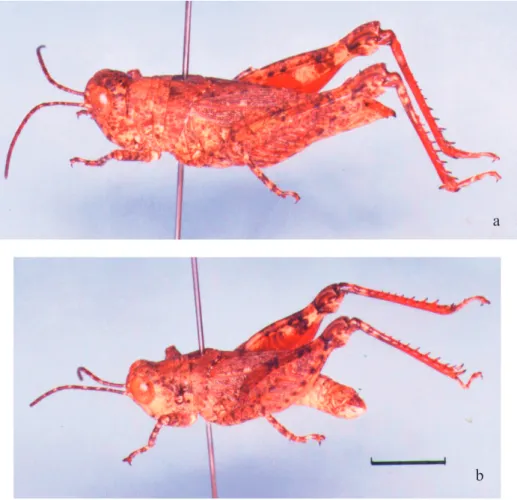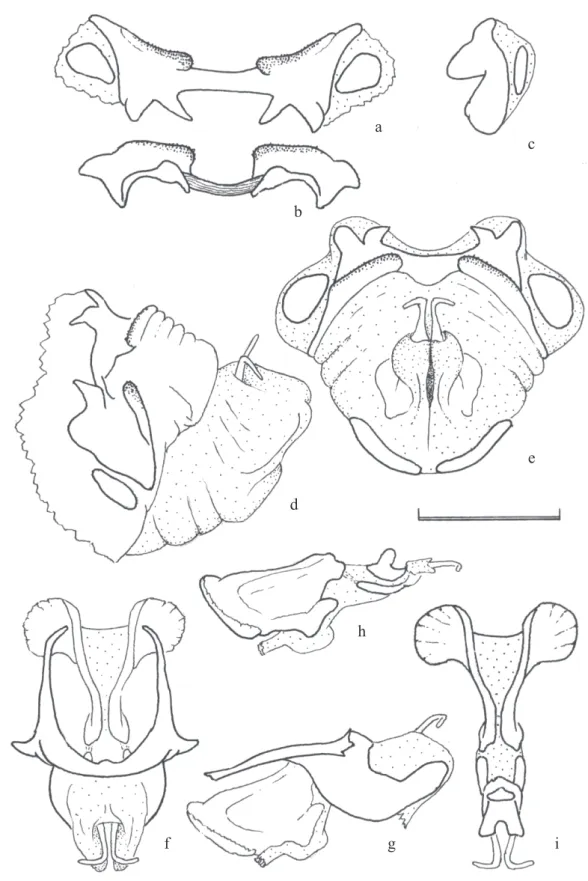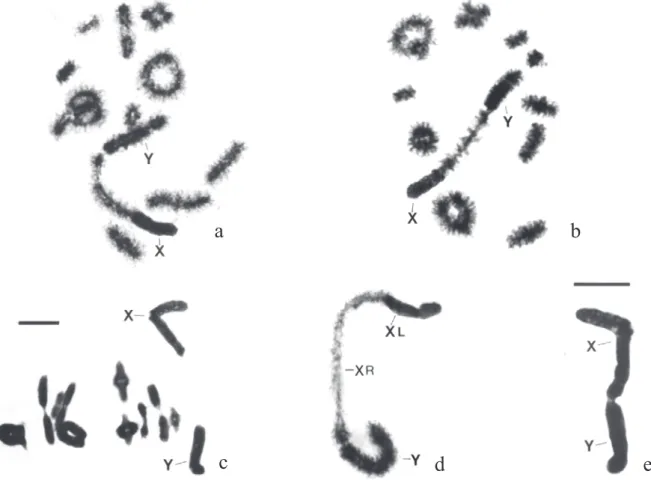The genus Dichroplus was considered by several entomologists to be an assemblage of several genera provisionally gathered under a single genus. Consequently, many of the species originally or secondarily assigned to Dichroplus have been recently transferred to other genera. These changes are reported as follow:
In 1977, Rowell & Carbonell erected the genus Baeacris, for D. talamancensis.
In 1981, Correa & Alves undertook a numerical phenetic classification scheme, based on external structural characters comprising 33 species of Dichroplus from the collection of the Biological Department of the UNESP Campus in Rio Claro.
In 1991, Ronderos & Cigliano described the news genus Ponderacris, including in it the following species of Dichroplus: auriventris (Bruner, 1913); bolivianus, cuzcoensis and inca (Ronderos & Carbonell, 1971) and peruvianus (Stål, 1878) and transferred the Dichroplus punctulatus species group to the genus Baeacris.
More recently, Cigliano (1997) erected the genus Ronderosia transferring from Dichroplus to that genus the following species: bergi (Stål, 1878), cinctipes, dubius, paraguayensis and robustus Bruner, 1906, forcipatus Rehn, 1918, gracilis, Bruner, 1911, malloi Liebermann, 1966 and piceomaculatus Carbonell, 1972.
According to Cigliano (1997) the following and unique combination of characters from both the phallic complex
Neotropical Entomology 35(5):632-637 (2006)
Ronderosia ommexechoides:uma Nova Espécie de Dichroplini Brasileira (Orthoptera: Acrididae: Melanoplinae)
RESUMO - Uma nova espécie do gênero Ronderosia Cigliano, 1997 é descrita. Ilustrações em cor de fêmea e macho, desenhos de fêmea e genitália externa do macho, assim como desenhos da estrutura fálica e fotografias de seus cromossomos são incluídos.
PALAVRAS-CHAVE: Gafanhoto neotropical, táxon novo, Caelifera, cromossomo
ABSTRACT - A new species of the genus Ronderosia Cigliano 1997 is described. Color illustrations of the female and male, drawings of female and male external genitalia as well as drawings of its phallic structures and photographs of the chromosomes are included.
KEY WORDS: Neotropical grasshopper, new taxon, Caelifera, chromosome
and the external morphology characterize the genus Ronderosia: body robust; head subglobose; pronotum expanded in metazona; apical valves of penis stout, cylindrical in cross section, sharply diverging caudally with their sclerotization reduced distally, sheath of penis narrow with prominent apical lobes.
The generic characters assigned to Ronderosia by Cigliano justify the inclusion of the new species described below in that genus. The specimens were collected in “cerrado” vegetation near the cities of Itirapina and São Carlos, in the State of São Paulo, Brasil. Due to its size, color pattern and length of tegmina, which only cover half of the abdomen, the species looks superficially similar to Ommexecha virens and for that reason we named it ommexechoides.
Ronderosia ommexechoides Carbonell & Mesa n. sp.
Material Examined
Holotype - Male nº 2 (Fig. 1). Locality: Brazil (SP), 11 km N of Itirapina, “Cerrado” vegetation, opposite to Broa dam, 20/XI/95, A Mesa, P. García (22°10’35"S-47°53’01"W). Paratypes - Sixteen females and five males collected as follows:
N BL HFL PDL MMW MPW MDE TL
16 20.0 ± 1.04 11.7 ± 0,42 5.2 ± 0.17 5.29 ± 0.18 4.16 ± 0.18 3.8 ± 0.17 6.3 ± 0.75
6 15.8 ± 0.61 9.6 ± 0.65 4.2 ± 0.21 4.0 ± 0.18 3.3 ± 0.17 3.3 ± 0.13 4.6 ± 0.32
17, 24-X-88, A. Mesa; nº 6, 5-V-89, A. Mesa; nº 15, 17-XI-89, A. Mesa; nº 1, 3, 4, 5, 7, 8, 9, 19; nº 21, 22; 20-XI-95, A. Mesa, P. García; nº 16, 16-III-90, A. Mesa. B) From Brazil (SP) 8 km W of Itirapina in “cerrado” vegetation, 22°15’40"S-47°53’50"W. nº 14, nº 19, 18-II-90, A. Mesa, C. S. Carbonell; nº 10, 11, n° 20, 6-X-93, A. Mesa; nº 12, nº 23, 30-IX-95, A. Mesa.
Male holotype and female paratype deposited at the Museu Nacional of Rio de Janeiro. Paratypes kept in the insect collections of the Biology Department of UNESP (Universidade Estadual Paulista Julho de Mesquita Filho, Rio Claro, SP) an in the Laboratory of Entomology of the College of Sciences, Universidad de la República, Montevideo, Uruguay.
Diagnosis. Small for the genus, head globose, brevialate, integument mat on upper surface and legs, shiny ventrally; dorsally cream-colored mottled with fuscous, ventrally cream-colored; lower surface of hind femora and apical 3/5 of hind tibiae scarlet. Males XY, with Y showing a short pericentric inversion.
Description
Body morphology and coloration. (Figs. 1, 2 and 3) Size rather small within the genus (Table 1). Robust, brevialate. Integument mat, strongly pilose particularly on the legs, becoming slightly shiny on abdomen and ventral surface of body. Head: eyes prominent but not surpassing the level of
Fig. 1. R. ommexechoides a) female. b) male. Enlargement bar = 5mm
Table 1. Body measurements.
BL = body length; HFL = hind femur length; PDL = pronotal dorsal length; MMW = maximum metazonal width; MPW = maximum prozonal width; MDE = Maximum distance between eyes external borders; TL = Tegmina length
a
the vertex in lateral view; vertex strongly convex, roundly curving into fastigium and frons; fastigium with lateral carinae marked but not very prominent; frontal costa with edges parallel to median ocellus, then diverging slightly downwards in male, in the female they diverge very slightly from their inception downwards; in both sexes they become indistinct towards the epistomal suture; antennae in males and females slightly longer than head and pronotum together. Tegmina in both sexes approximately as long as head and pronotum together, apically acute, reaching the middle of abdomen. Pronotum in dorsal view: metazoan slightly longer than prozona in females, of equal length in males: anterior edge straight, posterior one projecting caudad in a right angle. Male cerci upcurved, its apical third tapering to a pointed apex.
Chromatic characters [color names according to Smithe (1975)]. Cream-color profusely mottled with fuscous on dorsal and lateral surfaces, including tegmina. Ventral surface of body uniformly cream-color. Antennae: scape and pedicel cream-colored; flagellum inferiorly fuscous; superiorly the first four basal segments and the five or six apical one fuscous, those in between alternately cream and fuscous. Internal side of hind femora: base cream-color; anterior part of region of
pinnae and most of its lateral-inferior surface scarlet; apical half transversally banded, cream-color and fuscous; base of rotular area fuscous, apical part cream-color inferiorly, clay-color above. Hind tibiae: inside with basal 2/5 banded cream-color and chestnut, apical 3/5 scarlet. On the outside the scarlet part slightly longer; tibial spines mostly scarlet with black apices.
Dorsal phallic apical valves diverging laterally and tapering towards apices. Phallic sclerites as in Fig. 3.
Chromosomes. (Fig. 4) The chromosome number in R. ommexechoides is 2n = 20A + neoXY – 2n = 20A + 2neoX. The autosomes include two long, five medium size and three small pairs of acrocentric chromosomes. The sex chromosomes are of the neoXY( ) type originated in a centric fusion between the original X with an autosome belonging to a long pair.
During early diplotene (Fig. 4d) the XL (the original X) remains wholly heterochromatic while XR (the autosomal component) appears euchromatic, but with its distal end slightly heterochromatic. The Y chromosomes instead, even than strongly heterochromatic it is less condensed than XL. A single chiasma connects the distal
Fig. 2. R. ommexechoides. a) female. b) inner face of right femur. c) male dorsal view of last segments of abdomen. d) male lateral view of circus. Enlargement bar = 5mm
a
b
Fig. 3. R. ommexechoides phallic structure. Epiphallus in dorsal view. b) idem in rear view. c) idem in lateral view. d) dorso-lateral view of the phallus before removing the membranes. e) idem in rear view. f) cingulum and dorsal valves with diverging ends. g) idem, in lateral view. h) endophallic plates and dorsal and ventral valves in lateral view. i) idem in dorsal view. Enlargement bar = 1mm
a
c
b
e
d
h
e. This constriction is easily detected during the diakinetics stages as seen in Fig. 4a, b.
The species closest to R. ommexechoides is apparently R. dubia (Bruner, 1906).
Discussion
In Cigliano’s (1997) key to the species of the genus Ronderosia, the present species would fall into the second alternative “head and pronotum without post-ocular dark band”, which includes forcipata (Rehn, 1918), paraguayensis (Bruner, 1906), dubia (Bruner, 1906),
Cryptosacci group of families is 2n = 23 - 24 with a X0 ( ) / XX( ) chromosomal mechanism of sex determination. The great majority of living grasshoppers exhibits this karyotype. In more than a hundred Australian species analyzed (Mesa, unpublished) in the period 1965-70 only two species showed derived karyotypes (Percassa rugifrons with an A-A centric fusion and Stenocantantops angustifrons with a recent and partially spread X-Y centric fusion). Some of the neotropical species of grasshoppers as the Romaleidae and the Gomphocerinae and Acridinae follow this pattern of karyologycal stability, but in some other groups as in the Melanoplinae, a surprising amount of species have derived
Fig. 4. R. ommexechoides. a) diakinesis. b) idem. c) first metaphase. d) neo XY pair with distal contact between Y and XR during diplotene stage. e) idem, during first metaphase. Enlargement bar = 10 µm (In “c”, valid for that figure; in “e” valid for the remaining figures).
d
a
c
e
karyotypes, the reason for this high degree of chromosomal mutation remaining unknown. Mesa et al. (1982) reported basic information on the karyotypes of nearly three hundred neotropical species. Within Melanoplinae, 93 species were studied and 47% of them had derived karyotypes. If only the Dichroplini is considered the percentage is even higher with nearly 75% of species (39 in 53) being derived. Ten species have been included within the Ronderosia genus and six of them were cytologically studied (bergi, dubia, paraguayensis, piceomaculata, robusta and ommexechoides) all of them with derived karyotypes (Mesa et al. 1982 and this paper). It is relevant to point out that more than fifty Neotropical species have neo XY males and a dozen of them X1X2Y sex determining mechanisms. The difference in age of this mechanisms and its corresponding degree of differentiation allowed the interpretation advanced by Mesa et al. (2001) in relation to a probable extinction of those species at the end of the differentiation process when the XR arm become wholly heterochromatic at the beginning of the first prophase.
The alteration of the ancestral acridid (Cryptosacci) karyotype due to a X-A centric fusion and the removal of the Y centromeric region from a near terminal position, giving rise to a well developed small arm in consequence of a short pericentric inversion contribute to clearly characterize the species R. ommexechoides.
Acknowledgments
The authors are grateful to Paula García-Novo who collaborated collecting specimens and typing the manuscript.
References
Bueno, O.C. & R.A. da Cunha. 1981. Fenética de algumas espécies do gênero Dichroplus (Orthoptera, Acrididae). Ver. Bras. Entomol. 22: 217-226.
Cigliano, M.M. 1997. Ronderosia, a new genus of South American Melanoplinae (Orthoptera, Acrididae). J. Orthopt. Res. 6: 1-19.
Mesa, A., A. Ferreira & C.S. Carbonell. 1982. Cariología de los acridoideos neotropicales: Estado actual de su conocimiento y nuevas contribuciones. Ann. Sac. Entomol. Fr. (N. S.) 18: 507-526.
Mesa, A., C.S. Fontanetti & P. García-Novo. 2001. Does an X-autosome centric fusion in Acridoidea condemn the species to extinction? J. Orthop. Res. 10: 141-146.
Ronderos, R.A. & M.M. Cigliano. 1991. The Andean Dichroplini: Cladistic analysis with description of Keyacris n. gen. and
Ponderacris n. gen. (Orthoptera: Acrididae: Melanoplinae). Trans. Amer. Entomol. Soc. 117: 167-191.
Rowell, C.H.F. & C.S. Carbonell. 1977. Baeacris talamancensis
genus and sp nov. (Acrididae, Melanoplinae) a neotropical montane grasshopper, its implications for the origin of the Dichroplini and the Costa Rican paramo. Acrida 6: 55-74.
Smithe, F.B. 1975. Naturalist’s color guide. American Museum of Natural History, N. York, 8p. (unnumbered) + 19 color plates (unnumbered).


